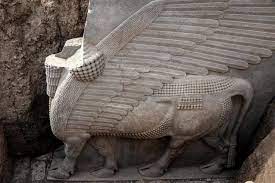Discovered in Iraq, a 2,700-year-old sculpture depicting the winged Assyrian deity Lamassu
An astonishingly massive, 2,700-year-old alabaster sculpture of the winged Assyrian god Lamassu was discovered mostly intact by researchers during an excavation in northern Iraq. According to Archeology Magazine, a magazine of the Archeological Institute of America, just its head was missing.
The statue was discovered in the Iraqi hamlet of Khorasabad and dates back to the eighth century BC by a team of archaeologists headed by French and Iraqi experts. On October 24, a sculpture of the Assyrian deity Lamassu was discovered. It is composed of alabaster stone, which is also used to make vases, sculptures, and other ornamental objects.
By virtue of having a bull’s body, an eagle’s wings, and a man’s head, the god represented power, courage, and wisdom in the eighth century BC. It is among the most highly valued finds made by archaeologists in the last several years. Following the dig, Pascal Butterlin, an archeology professor at Paris-Sorbonne University, said that the reason the head of Lamassu was absent was because it had been chopped off and taken by smugglers, and that it had been found later by Baghdad customs. “The head is currently, I believe, in the museum in Baghdad.” The remainder of the corpse was discovered here and is in very good condition, according to Pascal Butterlin, who was cited by Euro News.
Pascal Butterlin said that he had never discovered something this significant in his life prior to this accomplishment. Normally one may find these enormous statues in Egypt or Cambodia, so he was taken aback to see the whole statue of the Assyrian god in Iraq. One single block of limestone was used to create the statue, which has an 18-ton weight. According to reports, the sculpture is between 3.8 and 3.9 meters tall.
Victor Place, a French archaeologist, was the first to describe the monument of this Assyrian god. However, when Iraqi authorities designated it as an urgent intervention, the statue was eventually removed from public records until the 1990s. It is said to have been built near the gateway to the historic city of Khorsabad. During the reign of King Sargon II, it was commissioned. He was placed at the city’s gates as protection against the intruders and governed from 722 to 705 BC.







